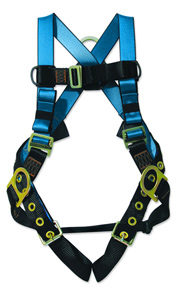
More and more women are taking on roles in industries previously dominated by men. The construction industry is just one of them, and a growing number of women have become a part of this workforce. From engineers to architects to skilled laborers, women are finding a place that fits their aptitude and skills right alongside men.
Yet, like most traditionally male-dominated industries, women face different—and sometimes more—challenges than men thanks to long-held occupational assumptions and stereotypes. Among them is having the right safety equipment.
Like all construction workers, avoiding falls and other workplace injuries is something female workers need to be aware of. OSHA regulations require that all employers provide fall protection and other safety equipment. But in an industry that’s historically dominated by men, it’s easy to overlook having the right-sized personal protective equipment (PPE) for women on hand.
The Growing Female Construction Workforce
Of the 10 million people working in construction, there are currently more than 1 million women within this sector. What’s even more noteworthy is the fact that 40% of the women who work in the construction industry own their own businesses—it’s one of the largest areas of growth for new women-owned companies. As more women enter the workplace, the need for special personal protective equipment will also increase.
Why Do Women Need Special PPE?

In fact, any PPE that doesn’t fit properly can become a hazard that increases the risk of injury in the event of a fall or other accident. For example, a poorly-fitted safety harness may lead to trips, get caught in machinery, and may not be effective in the event of a fall. Likewise, a hat that’s too large may fall off, or gloves that are too big may not prevent contact with harmful substances.
Personal Protective Equipment Is a Safety Must
You already know that you have to provide all of your workers with fall protection devices whenever they’re working at height. And if you already have it in place, that’s great news. But are you sure your female workers are protected? If they are expected to share PPE with their male counterparts, they might not be.
In some cases, women are resorting to altering their equipment in an attempt to get a better fit. The problem is, alterations may weaken the device, nullify it’s OSHA compliance, and make injuries more likely. Ill-fitting protective equipment can also hinder a woman’s movements, making it difficult to efficiently perform tasks they could otherwise manage with ease. For some women in the construction and trade industries, a lack of well-fitted personal protection equipment can sometimes lead to wearing none at all.
PPE Points to Consider
When reviewing your company’s PPE, remember the following:
- Work Boots Aren’t Unisex – Women’s feet are usually shorter and narrower than men’s feet and they require boots designed specifically for them. Women who wear men’s boots that are too large or wide may be at higher risk of trip and fall accidents and mobility issues.
- Gloves Should Fit Well – Men’s hands are larger than women’s and gloves designed for men are too big, bulky, and loose for a woman. Gloves that are fitted to a woman’s hand improve dexterity and coverage, assuring women stay safe and agile.
- Adequate Eye Protection – Men’s safety glasses can leave gaps around a woman’s more slender face and put her at risk of eye injury. Female construction workers need protective eyewear that’s well-fitted to their face size to minimize the risks and to improve vision.
- Protective Head Gear – Hard hats designed for men are generally too large for a woman’s smaller head. This can result in the hard hat falling off or tipping into the woman’s eyes causing obscured vision. Hard hats designed for a woman’s smaller head size are a safer, more comfortable alternative.
- Fall Protection Devices – Working at height sometimes requires a safety harness, fall protection lanyards, or self retractable lifelines. If these devices are too large for a female worker’s smaller frame, she could slip out of the harness, or become suspended without means of recovery.
PPE Reduces Workplace Hazards
When workers wear the appropriately sized personal protection equipment, they’re less likely to encounter a variety of workplace hazards. Instead of purchasing one size in bulk, actually take a look at your workforce and purchase PPE that suits each worker individually. Your workers will be safer on the job, more productive, and more likely to follow safety protocols if they know you’re truly looking out for them. They’ll also be more prone to encourage their co-workers to be more safety conscious, improving the company along the way.
Become Proactive and Protective
The construction industry has much to gain from the growing number of women within its ranks and now is a good time to address their personal safety. By being a proactive employer that focuses on the individual team members that make up your workforce, you can better protect them. Instead of expecting your female workers to make due with inadequate, ill-fitting, or no personal protective equipment, outfit them properly. Not only does that mean you’ll remain compliant with OSHA, but it’s also a wise business move. What’s more, having the right-sized hard hats, goggles, gloves, harnesses, and fall protection lanyards and self retractable lifelines helps instill a culture of safety throughout your business.
If you need another reason to provide PPE for female workers, think about your company’s future growth. You’re always on the lookout for top talent and many of those candidates are women. If you can demonstrate that your company puts their safety above all, you’ll attract more of them and build a stronger, more diverse workforce. This simple change in mindset can benefit your company now and long into the future.





